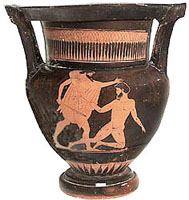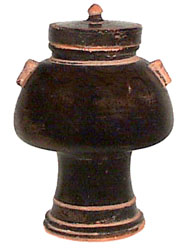Kraters

The term 'krater' suggests a mixing-vessel (compare Greek kerannumi - to mix), and we know that the wine served at the symposium was mixed with water. On vases decorated with symposium-scenes, a large open container with a foot is often depicted, and the name krater is appropriate. Examples can be traced back to the large Geometric examples that were used as grave-markers, and this funerary connection continues to be important. Excavations of burial-sites have shown that they could be used in Greek settlements overseas as containers of ashes, and South Italian, especially Apulian, volute-kraters often carry explicit funerary iconography. In the Athenian repertoire, there are four main types identified today: column-, volute-, calyx- and bell-. The psykter is a short-lived shape, used to cool the liquid. It is discussed here because it is often shown being used in kraters.
Column-krater

Named for its column-like handles, the column-krater is first known from Corinthian examples dated to the late seventh century. It is regularly produced by Athenian potters from the first half of the sixth-century until the third quarter of the fifth. It seems from graffiti on Athenian red-figure examples that the vessel was referred to as Korinthios or Korinthiourges.

- Athenian red-figure column-krater ht. 35cm.
Volute-krater
 The volute-krater is named after its handles. The François Vase is a famous and early example, but the typical Athenian form
occurs only later in the sixth century, with the handles tightly curled so that they look like the volutes on Ionic columns. The shape is also found in metal. Over the course of the fifth and fourth centuries, examples become slimmer, and Apulian volute-kraters from South Italy are particularly elaborate.
The volute-krater is named after its handles. The François Vase is a famous and early example, but the typical Athenian form
occurs only later in the sixth century, with the handles tightly curled so that they look like the volutes on Ionic columns. The shape is also found in metal. Over the course of the fifth and fourth centuries, examples become slimmer, and Apulian volute-kraters from South Italy are particularly elaborate.

- Athenian red-figure volute-krater ht. 46.5cm.
Calyx-krater
 The handles of the calyx-krater are placed low down on the body, at what is termed the cul. Their upward curling form lends the shape
an appearance reminiscent of the calyx of a flower, hence the name. The earliest known example
was possibly made by Exekias in the third quarter of the sixth century. It continues to be produced, mainly in red-figure, becoming more
elongated over the course of the fifth and fourth centuries.
The handles of the calyx-krater are placed low down on the body, at what is termed the cul. Their upward curling form lends the shape
an appearance reminiscent of the calyx of a flower, hence the name. The earliest known example
was possibly made by Exekias in the third quarter of the sixth century. It continues to be produced, mainly in red-figure, becoming more
elongated over the course of the fifth and fourth centuries.

- Athenian red-figure calyx-krater ht. 39.5cm
Bell-krater
 The latest of the four krater-types, it first occurs in the early fifth century, and is not found decorated in black-figure. It is
named for its bell-like shape, perhaps originating in wood. It has small horizontal upturned handles just over halfway up the body.
Some do not have a foot, and earlier examples may have lugs for handles. Over the course of the fifth and fourth centuries, the shape
becomes slimmer.
The latest of the four krater-types, it first occurs in the early fifth century, and is not found decorated in black-figure. It is
named for its bell-like shape, perhaps originating in wood. It has small horizontal upturned handles just over halfway up the body.
Some do not have a foot, and earlier examples may have lugs for handles. Over the course of the fifth and fourth centuries, the shape
becomes slimmer.

- Athenian red-figure bell-krater ht. 35cm.
Psykter
 The psykter (compare Greek psuchein - to cool) is a distinctive mushroom-shaped vessel that provided a means of
cooling wine. The name seems appropriate, although whether it was applied to this shape in the sixth and fifth century is unknown.
It is depicted placed within kraters, and those that are decorated sometimes play on the fact that that they would be seen half-immersed.
Whether the krater held the ice or chilled water, and the psykter the wine, or vice-versa, remains uncertain. There had been occasional
examples of vessels made with an inner chamber, seemingly for a similar end, but the psykter-shape is developed only in the late sixth
century, and production seems to have ceased by the mid-fifth century.
The psykter (compare Greek psuchein - to cool) is a distinctive mushroom-shaped vessel that provided a means of
cooling wine. The name seems appropriate, although whether it was applied to this shape in the sixth and fifth century is unknown.
It is depicted placed within kraters, and those that are decorated sometimes play on the fact that that they would be seen half-immersed.
Whether the krater held the ice or chilled water, and the psykter the wine, or vice-versa, remains uncertain. There had been occasional
examples of vessels made with an inner chamber, seemingly for a similar end, but the psykter-shape is developed only in the late sixth
century, and production seems to have ceased by the mid-fifth century.

- Athenian psykter ht. 12cm.





